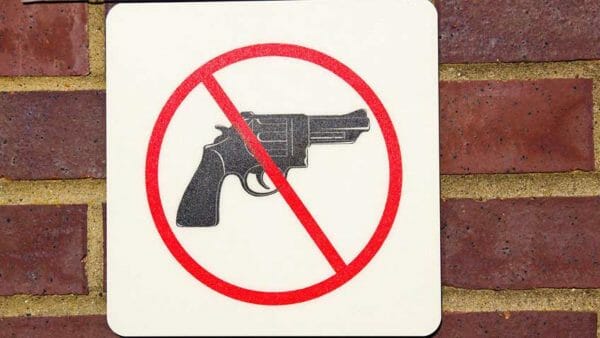Opinion

New York – -(AmmoLand.com)- The New York Government, under Governor Kathy Hochul and the Democrat Party-led Legislature in Albany, have declared outright war on the precepts of Individuality upon which the U.S. Constitution rests.
Hochul’s Government crafted a comprehensive set of amendments to New York’s Gun Law, the Sullivan Act.
These amendments specifically and negatively affect N.Y. Penal Law § 400.00(2)(f). That’s the concealed handgun carry license section of the State’s Sullivan Act.
The amendments are referred to collectively as the “CCIA.”
Hochul signed the amendments into law on July 1, 2022. This was scarcely a week after the High Court published the Bruen decision, on June 23, 2022.
A flurry of lawsuits followed. Plaintiff gun owners filed the first one, Antonyuk vs. Bruen (Antonyuk I), on July 11.
The U.S. District Court for the Northern District of New York dismissed that case without prejudice on August 23.
Ivan Antonyuk, the captioned Plaintiff of Antonyuk I, refiled his lawsuit against Defendant Kevin Bruen, Superintendent of State Police, on September 20. Five additional individuals joined as Plaintiffs. And they added eight additional Defendants. Governor Kathy Hochul was one of those Defendants.
The New York Courts refer to this second case as Antonyuk II. The case was formally recaptioned, Antonyuk vs. Hochul.
On September 22, the Plaintiffs filed their Emergency Motion for a Temporary Restraining Order, and on September 28, they added a Motion for Preliminary Injunction (“PI”).
The Oral Hearing was held on September 29, 2022.
On October 6, the U.S. District Court issued its order, granting the TRO in part, and denying it in part.
One month later, on November 7, the District Court ruled on the Plaintiffs’ Preliminary Injunction, granting it in part, and denying it in part.
The Court also dismissed out Governor Hochul as a Party Defendant, ruling that, “Plaintiffs have not alleged or shown how Defendant Hochul could be properly found to have the specific legal duty to enforce the CCIA.”
In addition, Steven Nigrelli was named the new Superintendent of the State Police, replacing Kevin Bruen, as Party Defendant.
With both Hochul and Bruen out of the picture, the case, Antonyuk II, was recaptioned, Antonyuk vs. Nigrelli.
With the granting of the Preliminary Injunction, the TRO was mooted, and the Parties jointly agreed to dismiss the TRO.
- On November 8, 2022, the New York Gubernatorial race was held. On that same date, the Government appealed, to the Second Circuit, the District Court’s granting of the PI in Antonyuk II.
- On November 15, 2022, the Second Circuit issued a terse stay of the PI, pending its ruling on the Government’s Motion requesting relief from the District Court’s granting of the PI.
The Second Circuit November 15 Order reads:
“Defendants-Appellants, seek a stay pending appeal, and an emergency interim stay, of the Preliminary Injunction issued by the District Court on November 7, 2022.
It is hereby ordered that a temporary stay is granted, pending the panel’s consideration of the motion.”
The Second Circuit obliged the Government, overturning the U.S. District Court’s grant of the PI stay. This means Hochul’s Government can enforce the CCIA during the Second Circuit’s review of the PI.
Time is therefore on the side of the Government.
Hochul Government now has what it wants—the ability to enforce the CCIA against New York’s Gun Law during the Second Circuit’s review of the PI.
Plaintiffs and all other holders of valid concealed handgun carry licenses as well as those who wish to obtain a New York concealed handgun carry license must now contend with the CCIA.
Present holders of a valid New York concealed handgun carry license like the Plaintiffs in Antonyuk II, are particularly negatively affected by this Order. Plaintiffs understandably were not happy about the Second Circuit’s November 15 Order, lifting the stay of the CCIA imposed by the U.S. District Court for the Northern District of New York. So, four days after the issuance of the Second Circuit’s November 15 Order, the Plaintiffs, on November 19, Plaintiffs filed their response to the Government’s stay of the PI pending the Circuit Court’s review of it.
The Plaintiffs took the Government to task, stating,
“In their Motion, Appellants generally malign the district court’s preliminary injunction, but fail to note that the CCIA is no ordinary law–breathtaking in both its scope and its blatant unconstitutionality. The district court was correct to enjoin enforcement of many of the CCIA’s patently unconstitutional provisions, and this Court should (i) decline Appellants’ invitation to be the first circuit court to bless a statute specifically enacted to defy Bruen, (ii) vacate its improvidently granted administrative stay, and (iii) deny Appellants’ Motion.”
Whether to enforce the operation of the CCIA during litigation or stay its enforcement turns on a four-factor test created by the Second Circuit.
The Plaintiffs addressed the four-factor test in their Opposition to the Government’s Motion, stating—
“The relevant factors to be considered are ‘[i] the applicant’s strong showing that [they are] likely to succeed on the merits, [ii] irreparable injury to the applicant in the absence of a stay, [iii] substantial injury to the nonmoving party if a stay is issued, and [iv] the public interest.’ A stay ‘is not a matter of right, even if irreparable injury might otherwise result;’ rather ‘it is an exercise of judicial discretion, and [t]he party requesting a stay bears the burden of showing that the circumstances justify an exercise of that discretion.” Finally, where (as here) an applicant is ‘totally lacking’ a strong showing of likelihood of success, ‘the aggregate assessment of the factors bearing on issuance of a stay pending appeal cannot possibly support a stay.’ Appellants fail all four factors. . . .
The district court’s order will cause no harm to Appellants, as many of the CCIA’s provisions – which have been in effect barely over two months – are entirely novel in New York law, as well as lacking any historical analogue. . . . The sky did not fall prior to the CCIA’s enactment, and the sky is not falling now. Rather, the PI merely returns the state of the law to what it was just over two months ago.”
Responding to the Plaintiffs’ Opposition to the stay of enforcement of the CCIA, the Second Circuit issued an amended Order on December 7, 2022.
The new Order reads:
“Appellants request a stay pending appeal of the district court’s order dated November 7, 2022 (N.D.N.Y. 22-cv-986, doc. 78), enjoining Appellants from enforcing certain aspects of New York’s Concealed Carry Improvement Act (‘CCIA’). Having weighed the applicable factors, see In re World Trade Ctr. Disaster Site Litig., 503 F.3d 167, 170 (2d Cir. 2007), we conclude that a stay pending appeal is warranted. Accordingly, upon due consideration, it is hereby Ordered that the motion for a stay pending appeal is Granted and the district court’s Nove1nber 7 order is Stayed pending the resolution of this appeal. To the extent that the district court’s order bars enforcement of the CCIA’s provisions related to persons who have been tasked with the duty to keep the peace at places of worship, airports, and private buses, such categories are excepted from this order. Appellees’ motion to expedite the resolution of the matter is Granted.”
What this new Order means is this:
- The Second Circuit allows the Government to enforce the amendments to the State’s Gun Law during its review of the Preliminary Injunction, subject to a minor exception.
- The Second Circuit said the stay does not affect the “Sensitive Location” prohibitions to airports, places of worship, and private buses.
This is hardly a concession to the Plaintiffs.
Airports fall under the jurisdiction of the Federal Government, not the State.
No civilian may carry a firearm in airports, anyway.
And houses of worship and private buses are the only private entities that the Second Circuit says can devise their own rules for the carrying of firearms.
All other CCIA “Sensitive Location” provisions remain operative during the Second Circuit’s review of the PI.
But the Second Circuit’s treatment of the “four-factor test,” in the recent Order is both curious and disturbing. Recall the lower District Court had meticulously applied the Four-Factor test as it is required to do when first granting the Plaintiffs’ TRO, and subsequently granting the Plaintiffs’ PI. But why did the Second Circuit reject the findings of the District Court?
In lifting the PI stay, the Second Circuit never explained its reasoning for doing so.
The Court cites a case that is inapposite. And it is one that neither the Plaintiffs nor Defendants cite in their legal filings. The Court merely says it has weighed the factors and tacitly finds for the Government.
This is all contrary to the findings and cogent reasoning of the lower District Court.
It suggests the Court will overturn the PI, thus jeopardizing the attack on the constitutionality of the CCIA and further reducing the chance of eventually securing a Permanent Injunction against enforcement of the CCIA.
Welcome all to New York! Please Leave your Guns with the Sheriff! And have a pleasant stay!
About The Arbalest Quarrel:
Arbalest Group created `The Arbalest Quarrel’ website for a special purpose. That purpose is to educate the American public about recent Federal and State firearms control legislation. No other website, to our knowledge, provides as deep an analysis or as thorough an analysis. Arbalest Group offers this information free.
For more information, visit: www.arbalestquarrel.com.

